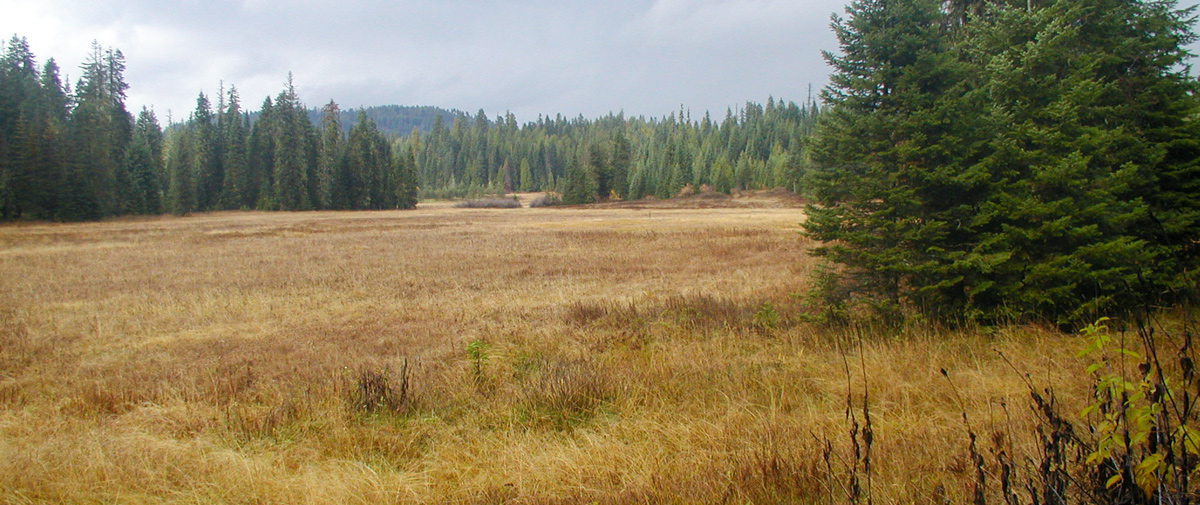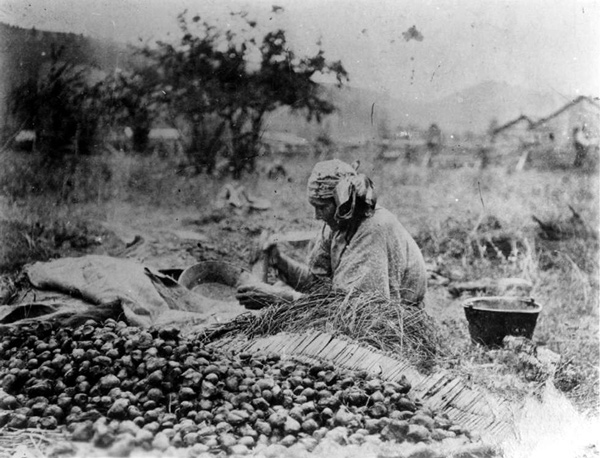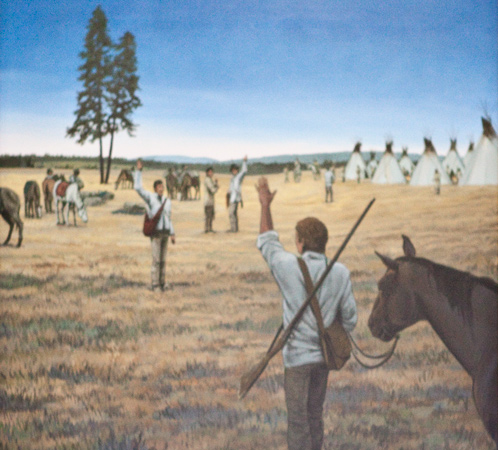Lewis and the main party descend to the Nez Perce villages at Weippe Prairie “having tryumphed over the rocky Mountains”. Clark and Twisted Hair climb up from the Clearwater River and the two captains re-unite. Communications rely on Plains Sign Language, and Twisted Hair draws a map of the Clearwater to the Columbia River on a white elk skin.
Elsewhere, a large deputation of Indians organized previously by Lewis assembles in St. Louis.
Two Different Perspectives
by Yellowstone Public Radio[1]Originally aired weekdays by Yellowstone Public Radio during the Bicentennial observance of 2003-2006. Narrated by Hal Hansen. Scripts by Whit Hansen and Ed Jacobson. Produced by Leni Holliman. © … Continue reading
Crane Meadow Nourishment
For Crane Meadow in the spring, see June 13, 1806.
we ascended a mountain, & went on some distance, & came to a smooth level clear place, where there was a clear run of water—. At this run, we were met with by Robert Fields, (one of the party that had went with Captain Clark,) and who Captain Clark had sent back to meet our party; this Man brought with him some Salmon, & other kinds of food, which they had purchased from some Indians
—Joseph Whitehouse
Mountain Triumph
the pleasure I now felt in having tryumphed over the rocky Mountains and decending once more to a level and fertile country where there was every rational hope of finding a comfortable subsistence for myself and party can be more readily conceived than expressed, nor was the flattering prospect of the final success of the expedition less pleasuing.
—Meriwether Lewis
Weippe Prairie Villages
on our approach to the village which consisted of eighteen lodges most of the women fled to the neighbouring woods on horseback with their children, a circumstance I did not expect as Capt. Clark had previously been with them and informed them of our pacific intentions towards them and also the time at which we should most probably arrive. the men seemed but little concerned, and several of them came to meet us at a short distance from their lodges unarmed.
—Meriwether Lewis
Camas Factory
these natives have a large quantity of this root bread which they call Commass. the roots grow in these plains. they have kills [kilns] engeaniously made where they Sweet these roots and make them Sweet and good to the taste—
—John Ordway
Weippe Reunion
we arrived at his Village at Sunet, & himself and myself walked up to the 2d Village where I found Capt Lewis & the party Encamped, much fatigued, & hungery, much rejoiced to find something to eate of which They appeared to partake plentifully. I cautioned them of the Consequences of eateing too much &c.
—William Clark
Difficult Communications
Those Indians Stole out of R. F. [Reubin Field] Shot pouch his knife wipers Compas & Steel, which we Could not precure from them, we attempted to have Some talk with those people but Could not for the want of an Interpreter thro’ which we Could Speake, we were Compelled to converse alltogether by Signs—
—William Clark
Chief Twisted Hair’s Map
I got the Twisted hare [Twisted Hair] to draw the river from his Camp down which he did with great cherfullness on a white Elk Skin, from the 1s fork which is a few seven miles below, to the lage fork on which the So So ne or Snake Indians fish, is South 2 Sleeps; to a large river which falls in on the N W. Side and into which The Clarks river empties itself is 5 Sleeps from the mouth of that river to the falls is 5 Sleeps at the falls
—William Clark
Large Indian Deputation
From St. Louis, The General Commander of the U.S. Army, James Wilkinson, writes to the Secretary of Defense, Henry Dearborn, regarding a large assemblage of Indians invited by Meriwether Lewis to visit Washington City.
St. Louis Septr. 22nd 1805
Sir,
I shall endeavour to limit the depending visit of the Missouri and Mississippi Chiefs, who have been invited by Capt. Lewis, to twenty, this deputation will consist of Riccara’s [Arikaras], Otto’s Missouris’ [Otoes and Missourias], Scioux [Sioux], Sacques [Sauks], Ayowas [Iowas] and Reynards [Foxes] . . . .
If these Visitants could have been assembled at an earlier period, they might have ascended to Pittsburgh in a Barge with a Military Crew . . . .
Ja: Wilkinson[2]Letters of the Lewis and Clark Expedition with Related Documents: 1783-1854, 2nd ed., ed. Donald Jackson (Urbana: University of Illinois Press, 1978), 259–60.
Weather Diary
Weather at rise
Wind at rise
Weather at 4 P.M. Wind at 4 P.M. fair S W fair S W purchased Some provisions roots &c Send Rubin Fields back with Some Provisions to meet Capt. Lewis.
—Meriwether Lewis and William Clark[3]To assist the reader, the editor of this web page has omitted the date column and spelled out some abbreviations.
Experience the Lewis and Clark Trail
The Lewis and Clark Trail Experience—our sister site at lewisandclark.travel—connects the world to people and places on the Lewis and Clark Trail.
Plan a trip related to September 22, 1805:

Weippe Prairie is a High Potential Historic Site along the Lewis and Clark National Historic Trail of the U.S. National Park Service. A 274-acre tract in the prairie is managed by the Nez Perce National Historic Park.
Notes
| ↑1 | Originally aired weekdays by Yellowstone Public Radio during the Bicentennial observance of 2003-2006. Narrated by Hal Hansen. Scripts by Whit Hansen and Ed Jacobson. Produced by Leni Holliman. © 2003 by Yellowstone Public Radio. |
|---|---|
| ↑2 | Letters of the Lewis and Clark Expedition with Related Documents: 1783-1854, 2nd ed., ed. Donald Jackson (Urbana: University of Illinois Press, 1978), 259–60. |
| ↑3 | To assist the reader, the editor of this web page has omitted the date column and spelled out some abbreviations. |





